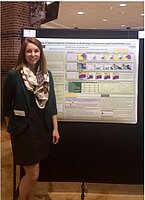Modeling of Runoff Contributing Areas and Hydrologic Connectivity and Applications in North Dakota

Kendall Grimm is a Ph.D. student in the Civil and Environmental Engineering Department at North Dakota State University. She holds a Bachelor of Science degree in Environmental Science with an Environmental Studies minor from the University of Wisconsin-Madison. Her present research topic is hydrologic modeling in depression-dominated areas like the Prairie Pothole Region (PPR) in North Dakota. She is focused on analyzing/identifying hydrologic connectivity patterns due to topography, and she is developing an improved modeling technique to account for depressional hydrologic processes and connectivity.
Fellow: Kendall Grimm
Advisor: Xuefeng Chu, Ph.D., Associate Professor, Department of Civil and Environmental Engineering, North Dakota State University.
Degree Progress: Ph.D. in Civil Engineering expected graduation in Summer 2018
Modeling of Runoff Contributing Areas and Hydrologic Connectivity and Applications in North Dakota
Various watershed delineation methods have been developed, which analyze surface topography differently. Traditional hydrologic modeling and delineation methods do not take into account the spatial arrangement and dynamic threshold control of depressions. Depression-dominated landscapes like those in the PPR in North Dakota need a hydrologic model that is able to account for the filling-spilling-merging processes of potholes. The objective of this 1-year project is to modify HEC-HMS, a widely-used traditional hydrologic model by taking into account the hydrologic effect of depressions and test the new model for some sites in North Dakota. First, the puddle delineation (PD) software is used to delineate subbasins, each of which is further divided into the two distinct areas: depressional and non-depressional areas. Second, the maximum depression storage (MDS), maximum ponding area (MPA), and puddle-based units (PBUs) of all subbasins in the study watershed are used to determine a “reservoir” release function that is dependent on rainfall excess. Lastly, the modified HEC-HMS model is tested and calibrated by using the observed hydrograph data. In addition, the model is validated by using additional storm events and observed discharge data. In particular, the changes in contributing area over time and the puddle threshold dynamics of the depression-dominated landscape are highlighted in this study.
Project Objectives:
The goal of this study is to analyze dynamic hydrologic connectivity patterns due topography in depression-dominated areas. The specific objectives are:
- To develop a new analysis technique (Normalized Connected Area Function, NACf) to understand dynamic hydrologic connectivity in depression-dominated areas that are not necessarily connected to a basin outlet, and
- To create a threshold control proxy to improve HEC-HMS modeling in depression-dominated areas.
Progress:
One manuscript devoted to dynamic hydrologic connectivity analysis in depression-dominated areas is currently under review. Another manuscript is under preparation based on the study done to improve HEC-HMS modeling in depression-dominated areas via a threshold control proxy. This second manuscript is expected to be submitted to a peer-reviewed journal by the end of 2017.
Significance:
Quantifying contributing area to the outlet is imperative when considering water resource availability. ‘Where is water going and where is water coming from’ are important questions that can be answered by using hydrologic models; however, these models must take into account impacts of the landscape topography. The foundation of this research stems from first understanding the surface topography. Only when there is a clear understanding of spatial and temporal variations in runoff contribution can these conclusions be transferred to modify large scale models. Many traditional large-scale models employ oversimplified methods to handle depressions and runoff initiation. By introducing variables like contributing area to puddles, contributing area to the outlet, and puddle filling-spilling-merging dynamics, a modified model is developed and used to simulate runoff from large scale depression-dominated areas.
Conference:
Kendall Grimm and Xuefeng Chu. “Modeling of Spatio-temporal Variations in Hydrologic Connectivity and Contributing Areas.” ND EPSCoR/IDeA 2017 State Conference, Fargo, North Dakota. (Poster)

Dr. Xuefeng (Michael) Chu
Director, ND Water Resources Research Institute & Civil and Environmental Engineering
Office: CIE 201K
Phone: (701) 231-9758
Email: xuefeng.chu@ndsu.edu


